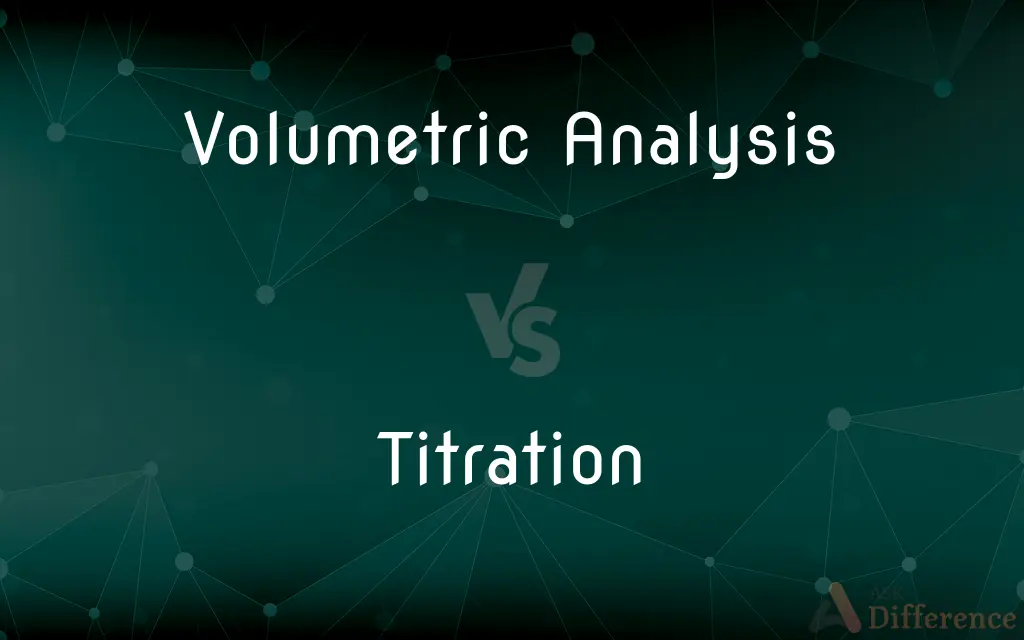Volumetric Analysis vs. Titration — What's the Difference?
By Tayyaba Rehman — Published on November 21, 2023
Volumetric analysis is a quantitative chemical analysis method using volume measurements; titration is a common technique within volumetric analysis where a solution's concentration is determined by adding a known reactant volume.

Difference Between Volumetric Analysis and Titration
Table of Contents
ADVERTISEMENT
Key Differences
Volumetric analysis is an overarching term referring to a category of methods in quantitative chemical analysis that utilizes volume measurements to determine the amount of a substance. Within the vast realm of volumetric analysis, various techniques can be employed to ascertain the concentration or quantity of a substance in a given solution.
Titration, on the other hand, is a specific technique that falls under the umbrella of volumetric analysis. This method involves incrementally adding a solution of known concentration, called the titrant, to another solution until the chemical reaction between the two solutions is complete. The endpoint of a titration is usually indicated by a change in color or electrical measurement.
While volumetric analysis encompasses a broader spectrum of techniques based on volume measurements, titration is narrowly defined by its incremental addition to reach an endpoint. It's important to note that every titration is a form of volumetric analysis, but not all volumetric analyses are titrations.
A key distinction between volumetric analysis and titration is their application spectrum. Volumetric analysis can be used in various scenarios where volume plays a crucial role in determining concentration or amount, while titration is specifically utilized when a known volume of one solution is required to react completely with another.
In essence, volumetric analysis represents a broader category of analytical techniques, and titration is a specific, widely recognized, and utilized method within this category.
ADVERTISEMENT
Comparison Chart
Definition
Quantitative method using volume measurements
Technique determining concentration by known reactant addition
Scope
Broader method encompassing various techniques
Specific technique within volumetric analysis
Endpoint
Not always applicable
Defined by a complete reaction or observable change
Techniques Included
Various volume-based methods
One specific method
Application Spectrum
Various scenarios using volume
Determining unknown concentration with a known reactant
Compare with Definitions
Volumetric Analysis
Volumetric analysis aids in determining the concentration or amount of a substance.
With volumetric analysis, researchers ascertained the pollutant's level in the water sample.
Titration
Titration is a procedure to find the concentration of a solution using a known reactant.
The student performed a titration to determine the acid's molarity.
Volumetric Analysis
Volumetric analysis is a method for quantifying substances using volume.
Through volumetric analysis, the lab determined the solute's concentration in the solvent.
Titration
It's a common technique in volumetric analysis.
Titration, a key component of volumetric analysis, offers precision and accuracy.
Volumetric Analysis
It relies on precise volume measurements for accuracy.
Accurate pipettes are essential tools in volumetric analysis.
Titration
Titration involves adding a titrant to a solution until a reaction is complete.
The endpoint of the titration was marked by a color change in the solution.
Volumetric Analysis
Volumetric analysis encompasses various techniques based on volume measurements.
Volumetric analysis methods are crucial in pharmaceutical manufacturing.
Titration
Titrations utilize indicators to signal their endpoint.
In the acid-base titration, phenolphthalein turned pink, indicating its completion.
Volumetric Analysis
Volumetric analysis is broad, with multiple techniques within its scope.
Gravimetric and volumetric analysis are fundamental to quantitative analytical chemistry.
Titration
The volume of titrant used provides insights into the analyzed solution's nature.
The titration results revealed that the sample had a lower concentration than anticipated.
Titration
The process, operation, or method of determining the concentration of a substance in solution by adding to it a standard reagent of known concentration in carefully measured amounts until a reaction of definite and known proportion is completed, usually as shown by a color change or by electrical measurement, and then calculating the unknown concentration.
Titration
(analytical chemistry) The determination of the concentration of some substance in a solution by slowly adding measured amounts of some other substance (normally using a burette) until a reaction is shown to be complete, for instance by the colour change of an indicator.
Titration
The act or process of titrating; a substance obtained by titrating.
Titration
A measured amount of a solution of unknown concentration is added to a known volume of a second solution until the reaction between them is just complete; the concentration of the unknown solution (the titer) can them be calculated
Common Curiosities
Is every volumetric analysis a titration?
No, while every titration is a form of volumetric analysis, not all volumetric analyses are titrations.
What indicates the endpoint in a titration?
The endpoint in titration is usually marked by a noticeable change, such as a color change or an electrical measurement.
Can titration be used outside of volumetric analysis?
No, titration is inherently a form of volumetric analysis as it's based on volume measurements.
Can volumetric analysis methods other than titration be used to determine substance concentrations?
Yes, volumetric analysis includes various techniques, not limited to titration, for determining substance concentrations.
What is volumetric analysis primarily used for?
Volumetric analysis is used for quantifying substances in a solution based on volume measurements.
Why is titration widely used in laboratories?
Titration is precise, straightforward, and provides quick results for concentration determinations.
What's the difference between the end point and the equivalence point in titration?
The endpoint is where an observable change occurs in titration, while the equivalence point is when stoichiometrically equivalent amounts of reactants have reacted.
How does titration fit within volumetric analysis?
Titration is a specific technique within volumetric analysis that determines a solution's concentration using a known reactant.
What is a titrant in the context of titration?
A titrant is a solution of known concentration used in titration to determine the concentration of another solution.
Why is it important to know the exact volume in volumetric analysis?
Exact volume measurements in volumetric analysis ensure accurate determinations of concentrations or amounts of substances.
What tools are essential for volumetric analysis?
Accurate measuring instruments like pipettes, burettes, and flasks are essential for volumetric analysis.
How is the accuracy of volumetric analysis ensured?
Accuracy in volumetric analysis is ensured through precise volume measurements, standardized solutions, and proper technique.
Can volumetric analysis be applied in industries other than chemistry?
Yes, volumetric analysis is widely used across various industries, including pharmaceuticals, food processing, and environmental monitoring.
Can titrations be performed on mixtures or only pure substances?
Titrations can be performed on both mixtures and pure substances, as long as the reaction is well-defined and the endpoint is discernible.
Do all titrations require indicators?
While many titrations use indicators to signal their endpoint, some rely on instruments like pH meters or conductivity meters.
Share Your Discovery

Previous Comparison
Merry Christmas vs. Happy Holidays
Next Comparison
Gross Profit Margin vs. Net Profit MarginAuthor Spotlight
Written by
Tayyaba RehmanTayyaba Rehman is a distinguished writer, currently serving as a primary contributor to askdifference.com. As a researcher in semantics and etymology, Tayyaba's passion for the complexity of languages and their distinctions has found a perfect home on the platform. Tayyaba delves into the intricacies of language, distinguishing between commonly confused words and phrases, thereby providing clarity for readers worldwide.











































